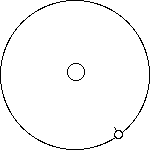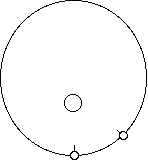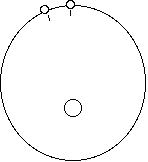
The earth and the sun (definitely not to scale!)
Some days are longer than others.
Material
To Do and Notice / What's Going On?
Place one person in the middle of the space, this person is the sun.
Have a second person stand about 5 paces away, this person is the earth.
Visualize a five pace radius circle around the sun. The earth moves around this circle once a year.
Give the Earth person a stick.
Let's investigate what a day would be if the earth were standing still in space.
Start with the earth-person facing the sun and holding the stick pointing straight in front of them toward the sun. When the stick points to the sun it is noon.

Have the earth person spin around, rotate, once. When the stick points at the sun again it is noon and one day has passed. One day is one 360 degree rotation. (This is what happens to distant stars, the earth doesn't move much compared to the very distant stars. It takes a star one earth rotation to go from being overhead to being overhead again. This is called a star-day or sidereal day and takes 23 hours 56 minutes.)
However the earth is also moving around the sun.
With the earth-person facing the sun and the stick at noon have them rotate once while at the same time they move one step to the side along the yearly circle.
Notice that they have to rotate around more than 360 degrees to have the stick point at the sun again.

The earth does too!
The earth moves about one degree to the side in its orbit each day and so has to rotate about 361 degrees from noon to noon. This takes longer than one 360 degree rotation and so the length of a solar day, from noon to noon, for an earth in a circular orbit is 24 hours. (See Math Root.)
The earth is in an elliptical orbit. It is closer to the sun in January and farther from the sun in July. Johannes Kepler discovered that in an elliptical orbit planets move faster when they are closer to the sun and slower when they are farther away.
Now have the earth-person stand 2.5 paces from the sun on one side of the orbit (later they will stand 7.5 paces on the other side.)
Once again have them rotate once but this time have them take two steps to the side. Notice that they have to rotate more than 360 degrees from noon to noon, and even more than they had to in the circular orbit because they are closer to the sun and moving faster to the side. The day is longer than 24 hours noon to noon.

Now have them move half-a-year around their orbit and stand 7.5 paces from the sun. Once again have them start with the sick pointing at the sun at noon then rotate once while moving half a pace to the side. Notice that they have to rotate around more than 360 degrees but they have to rotate less than they had to if they were in a circular orbit. The day is shorter than 24 hours noon to noon.

The length of the day is 24 hours when averaged over one year. Some days are shorter than 24 hours others are longer. Thus for half a year the sun returns to noon in less than 24 hours and for half a year it returns in longer than 24 hours. This contributes one element to the analemma which is also known as the equation of time.
Etc
When the earth moves around the sun in its orbit, it is said to revolve around the sun. Thus Copernicus' book was titled starting "De Revolutionibus" on the revolution of the heavenly bodies, that is about the orbits of the planets.
It is thought that perhaps the Greeks used 360 degrees in a circle because the sun moved once around the sky in 365 days, the number 360 was close to 365 and had many integer divisors. And thus,the sun moves around the sky relative to the stars about 1 degree a day.
Math Root
So how long does it take the earth to rotate one extra degree?
It takes the earth about 23 hours 56 minutes or 1436 minutes to rotate around 360 degrees. To rotate one degree thus takes:
1436 minutes/360 degrees = 4 minutes per degree
|
Scientific Explorations with Paul Doherty |
|
10 October 2001 |